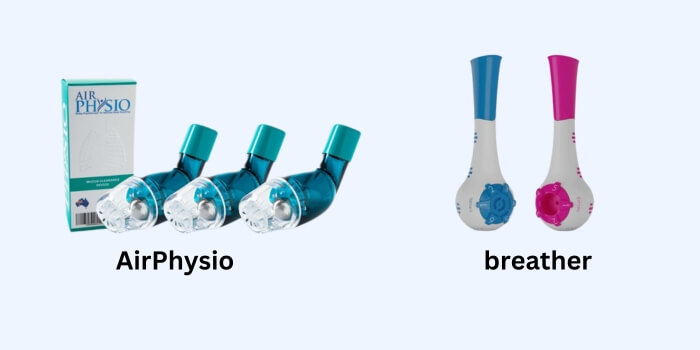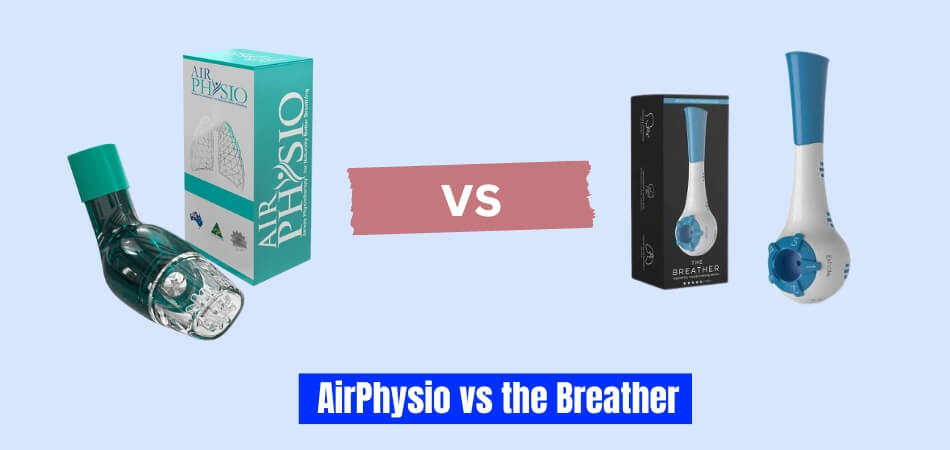The right device can make a world of difference when it comes to respiratory health in the long run. Inhalers are a common solution, but there's more to explore.
AirPhysio and the Breather are two notable respiratory aids. While comparing the AirPhysio vs the Breather, it will reveal an array of interesting factors.
Both devices aim to improve lung function but take different approaches. AirPhysio uses oscillating positive expiratory pressure to clear mucus, while the Breather strengthens respiratory muscles for better endurance.
Your specific needs will determine whether AirPhysio or the Breather is best for you. Join us as we dive deeper into these devices and help you make an informed choice.
Overview of AirPhysio & the Breather
AirPhysio and the Breather are two innovative devices designed to enhance respiratory health. AirPhysio has an original approach, utilizing oscillating positive expiratory pressure, or OPEP, to loosen and expel mucus from the airways.

This mechanism is especially beneficial for individuals with conditions like asthma, COPD, or cystic fibrosis, as it aids in clearing the lungs and improving breathing efficiency.
Breather, on the other hand, focuses on respiratory muscle training. This device aims to strengthen breathing muscles, such as the diaphragm and intercostal muscles.
As a result, it can improve lung strength and endurance, making it an excellent tool for athletes, singers, and anyone looking to improve their respiratory performance.
AirPhysio and the Breather offer distinct advantages, and the choice between them ultimately depends on your personal health goals and needs. Whether you're looking to clear mucus or build lung strength, these devices provide targeted solutions for better respiratory well-being.
Detailed Analysis of AirPhysio and the Breather
AirPhysio and Breather have carved out their specialty in respiratory devices, each offering unique benefits for different respiratory needs. We'll take a closer look at how these two devices work and who they are best suited for.
AirPhysio: Oscillating Positive Expiratory Pressure
AirPhysio operates on the principle of oscillating positive expiratory pressure (OPEP). When you exhale through the device, it creates resistance that oscillates, loosening mucus in the airways.
This process not only clears mucus but also expands the lungs and improves overall breathing capacity. It's particularly beneficial for individuals with asthma, bronchiectasis, or COPD, where mucus buildup is common.
The Breather: Respiratory Muscle Training
The breather takes a different approach, focusing on strengthening the respiratory muscles. Over time, it increases strength and endurance in the breathing muscles by providing resistance during both inhalation and exhalation.
The device improves lung capacity in athletes. It is also ideal for individuals recovering from respiratory illnesses, or even singers and musicians who rely on strong breath control for their performances.
While AirPhysio helps clear mucus and improve lung function, the Breather is about building respiratory muscle strength. Your respiratory health regimen might benefit most from one of these devices.
AirPhysio vs the Breather: A Head-to-Head Comparison
The Breather and AirPhysio are two respiratory devices that often come up in conversation. Despite their unique features, how do they compare?

This head-to-head comparison, we'll dive into the key aspects of AirPhysio vs the Breather to help you decide which one is the most appropriate fit for your respiratory needs.
As we cover all the bases, from their mechanisms of action to their suitability for different types of users, we'll cover everything you need to know.
Mechanism of Action
Oscillating positive expiratory pressure is used by AirPhysio to clear mucus from the airways. As you exhale, vibrations and resistance loosen mucus. People with asthma or COPD may benefit from this.
The Breather, on the other hand, focuses on respiratory muscle training (RMT). It provides resistance during both inhalation and exhalation, strengthening breathing muscles. Athletes, musicians, and anyone looking to improve their respiratory strength can benefit from this.
Ease of Use
Both devices are designed to be user-friendly but differ slightly. AirPhysio is straightforward to use; you simply breathe through the device to activate the OPEP mechanism. It doesn't require electricity or batteries, making it convenient for on-the-go use.
The Breather also boasts a simple design, with adjustable resistance levels to customize your training. However, it may take some practice to get used to the breathing techniques required for effective RMT.
Target Audience
AirPhysio is particularly well-suited to individuals with respiratory conditions that lead to mucus buildup, such as asthma, bronchiectasis, and COPD. It's also useful for post-operative lung recovery and smokers looking to improve lung health.
The Breather is geared towards a broader audience, including athletes seeking to boost their lung capacity, musicians and singers aiming for better breath control, and people recovering from respiratory illnesses or surgeries.
Price and Availability
Both devices are comparable in price, making them accessible options for those looking to invest in their respiratory health. They are available through various online retailers and can be easily purchased without a prescription.
As a result, the choice between AirPhysio and Breather depends on your specific needs and goals. The devices can enhance your breathing and overall lung function, no matter what your goal is, such as clearing mucus or strengthening your respiratory muscles.
Airphysio: How it Works?
AirPhysio is a unique device that has gained popularity for its effectiveness in improving lung function and clearing mucus from the airways. Let's dive into how this innovative tool works through a step-by-step breakdown.
Step 1: Preparation
Before using Airphysio, ensure you're in a comfortable position, sitting or standing upright. This posture helps maximize the effectiveness of the device.
Step 2: Exhalation
Place the mouthpiece of the AirPhysio in your mouth and exhale through the device. You should exhale normally, not forcefully, to initiate the oscillating positive expiratory pressure mechanism.
Step 3: Oscillation
As you exhale, the ball inside the AirPhysio creates vibration and resistance. This oscillation helps loosen the mucus stuck in your airways, making it easier to expel.
Step 4: Mucus Clearance
After using the Airphysio, you may feel the need to cough. This is a good sign, as it indicates that the mucus is moving out of your lungs. Coughing helps clear the loosened mucus from your airways.
The Breather: The Methods of Working
The Breather is a versatile respiratory device that's gaining traction for its ability to strengthen the muscles involved in breathing. Let's explore how this tool works through a step-by-step guide.

Step 1: Setting Up
Start by selecting the appropriate resistance levels for both inhalation and exhalation on the device. These can be adjusted based on your comfort and training goals.
Step 2: Positioning
Hold the Breather comfortably in your mouth, ensuring a tight seal around the mouthpiece. Sit or stand in an upright position to facilitate optimal breathing.
Step 3: Breathing Exercise
Inhale through the Breather, feeling the resistance as you breathe in. This resistance helps strengthen the diaphragm and other muscles involved in inhalation. Then, exhale through the device, again experiencing resistance that trains the muscles used during exhalation.
Step 4: Repetition and Progress
Repeat the breathing exercise for the recommended number of sets and repetitions. As your respiratory muscles become stronger, you can gradually increase the resistance levels to continue challenging your muscles and improving your lung capacity and endurance.
The Breather allows you to enhance your respiratory strength. It is ideal for athletes, singers, and anyone looking to improve their breathing.
Which One Should You Buy?
Choosing between AirPhysio and the Breather can be a bit of a puzzle, but it all comes down to your individual needs and goals. Let's break down some key points to consider when deciding which one to buy:
- Respiratory Conditions: AirPhysio might be the better option for people with asthma, COPD, or cystic fibrosis. As it oscillates, it helps clear mucus from the lungs.
- Respiratory Muscle Training: The Breather may be the ideal solution for anyone looking to strengthen their breathing muscles, whether for athletic performance or singing. It targets breathing muscles during inhalation and exhalation.
- Ease of Use: Both devices are user-friendly, but if you prefer a simpler approach without the need for adjusting resistance levels, AirPhysio might be more straightforward.
- Portability: Both devices are compact and portable, making them easy to use on the go.
AirPhysio and the Breather are both great options, depending on what you need and what you want. Take these points into account, and you'll be able to make an informed decision.
FAQs
When considering respiratory devices like AirPhysio and the Breather, it's natural to have some questions. Let's dive into a few common FAQs to help you understand these tools better.
Is Air Physio Good for Smokers?
Absolutely! AirPhysio can be a game-changer for smokers looking to clear their lungs. The device helps get rid of mucus buildup from smoking, making it easier to breathe and improving overall lung health.
Is the Breather the Same as An Incentive Spirometer?
While both the Breather and incentive spirometers are used for lung exercises, they're not the same. The Breather is an inspiratory muscle training (IMT) device, which is more effective in strengthening the muscles involved in breathing.
Can Air Physio Help with Shortness of Breath?
Yes, AirPhysio can be beneficial for those experiencing shortness of breath. Clearing mucus from the airways allows for better airflow and can alleviate feelings of breathlessness.
Is the Breather Suitable for People with Asthma?
The Breather can be a useful tool for people with asthma. It helps strengthen respiratory muscles, which can lead to improved breathing control and reduced asthma symptoms.
Make a more informed decision regarding the best respiratory device for you by understanding AirPhysio and Breather capabilities and benefits.
Final Thought
During our exploration of AirPhysio vs the Breather, we examined their unique mechanisms and benefits. AirPhysio is ideal for those looking to clear mucus and improve lung function, particularly beneficial for smokers and individuals with respiratory conditions.
On the flip side, the Breather focuses on strengthening respiratory muscles, making it an ideal choice for athletes and anyone seeking better breath control. When deciding between the two, consider your specific needs and goals.
Whether you choose AirPhysio or the Breather, incorporating these devices into your routine can lead to enhanced respiratory health and a more comfortable travel experience.






